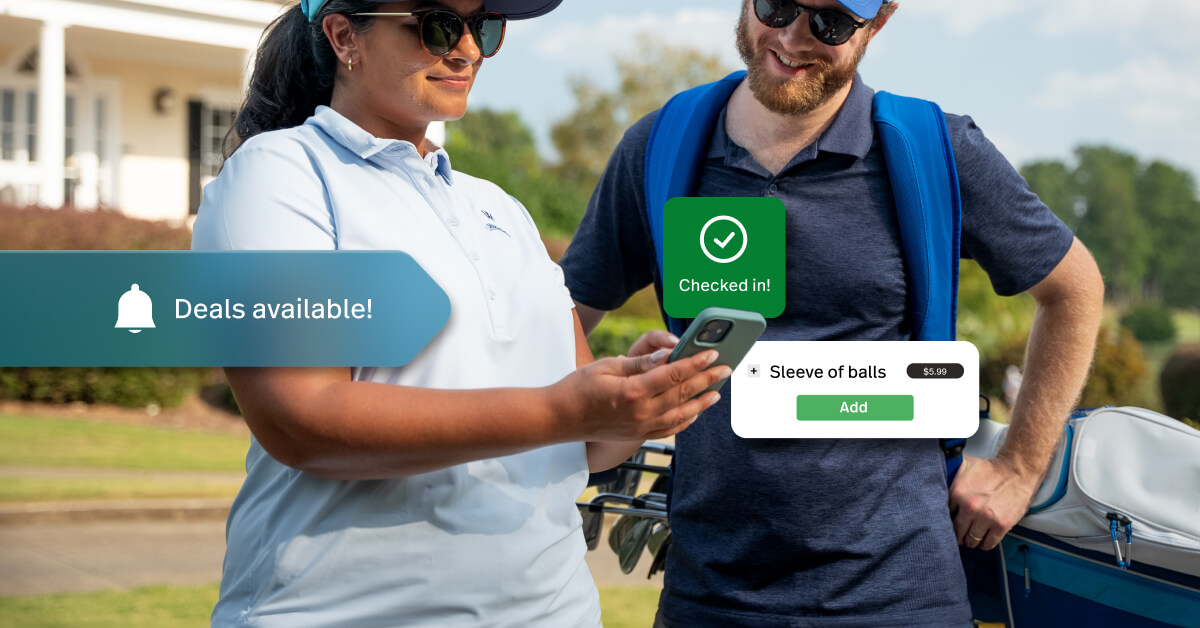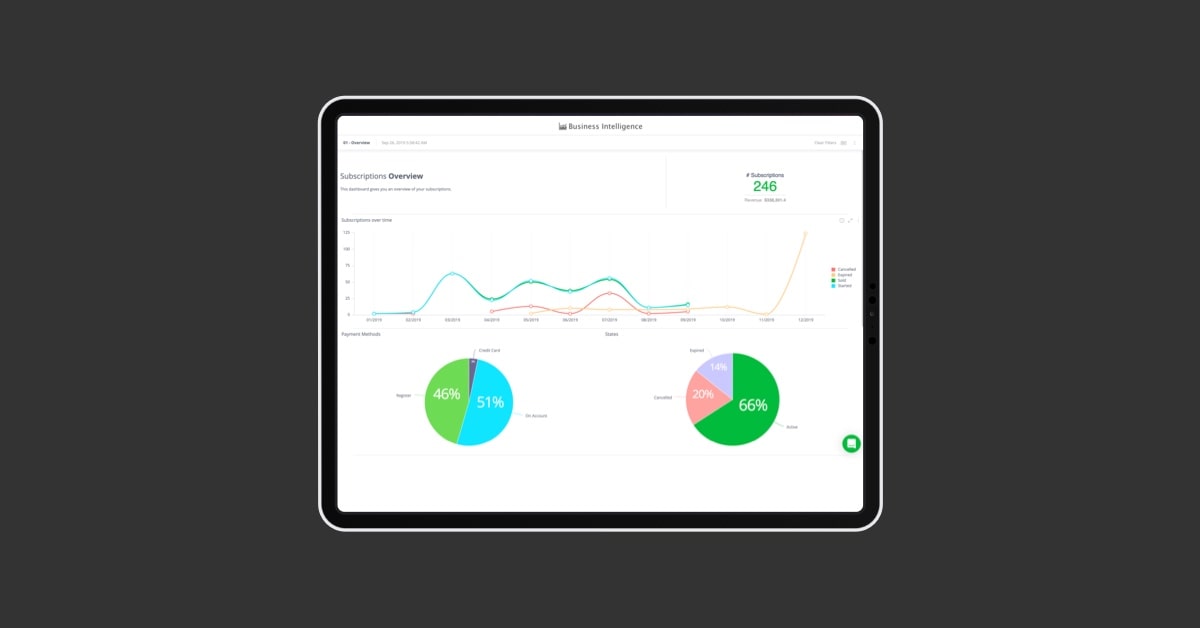
Ever wonder why some businesses take off and make a ton of money while others die? The answer often lies in the big decisions that management makes. Managers who base those decisions on hunches or intuition are taking a huge risk compared to those who use powerful data analysis.
As a golf course manager, you need to back up the decisions you make with the valuable insights that you gain from the information you collect and analyze.
Business Intelligence systems allow you to view all of the information you need to run your golf course in easy-to-understand reports. From there, you can make calculated choices based on real information, which will increase your return on investment and allow you to run a more profitable, efficient, and customer-centric golf course.
The Golf Management Software Buyers Guide
We created this handy guide to help you know what exactly to look for when searching for a new system.
What is a Business Intelligence system?
Business Intelligence refers to any business tools that provide relevant and meaningful data that measurably help you make better decisions. In a more practical sense, these systems analyze all of the data that comes through your golf course and aggregate it into powerful, easy-to-read reports.
In the past, gathering, organizing and analyzing data at this scale would have been a nightmare, even with a dedicated team of data analysts. But, modern BI software automates that entire process, giving small businesses the chance to operate with the same level of insights that were once only reserved for giant corporations. All you’re left with is tons of useful information that you can put into action.
If you’re already using a golf management software, chances are that you already have access to some tools, like occupancy reports. The issue with many systems is that these reports are often very limited and don’t allow you to drill deep down into data to look at information that you can actually use. Knowing which tee times sell best in a week is great, but knowing which tee times sell best based on specific segments like player types or spending habits is infinitely more powerful.
One of the best parts about BI software is that you can choose how granular you’d like your data to be. Your dashboards can give you a quick overview of what’s happening at your business on a macro level, but you can then dig much deeper into the data to find out the micro details.
How can Business Intelligence help your golf course?
We’ve already mentioned how Business Intelligence tools can help you make better decisions, but what exactly does that mean? In a more practical sense, detailed reports give you loads of data, which you can then pull information from to gain insights. Here are a few examples of the types of decisions that will be aided by BI tools:
1. Which customers you should market to?
Nowadays, social and customer analysis is considered the second most important big analytics use case. This field has become so important because not all customers are created equal; some bring in more revenue while others don’t. In a perfect world, you could target every segment equally, and bring in the maximum number of golfers from each group. However, in the real world, preferences change from customer to customer and your golf course won’t please every type of golfer on the planet. You need to make sure you’re sending out your marketing messages to people who will actually want to visit your course.
How do you decide which groups to target? Well, you can figure out how much money each group brings to your course per season by multiplying the average revenue per round played for that group by the average number of rounds that group plays per year. Once you have that number, you’ll be better equipped to decide how to go about marketing to those segments, and how much money you can spend on your marketing efforts while still maintaining a profit margin.
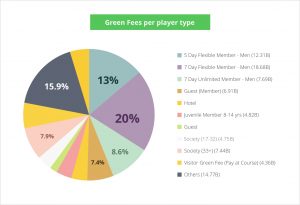
Drill down into data to segment it by player type
2. Which tee times should you discount?
This one is pretty obvious, but when you combine historical data with a dynamic pricing model, you can seriously improve occupancy rates and average revenue per available round.
Since tee times have an expiry date, the real value of a tee time fluctuates as the round approaches. Dynamic pricing and business intelligence help you understand this value and capture it.
Using BI software, you can look at which tee times sell best on a given day. Your busiest times will warrant a higher price because there is greater demand. Your least busy times will warrant a lower price because demand is lower, and a discount will make up for that less desirable tee time.
This kind of model will improve your occupancy rates by automatically discounting empty time slots at the perfect time while generating more money from time slots you know are going to sell. You won’t be left guessing, you’ll be able to easily develop a precise model by knowing the demand for each tee time.
3. Which pro shop merchandise you should sell?
Even if you’re the one ringing up the sales at your pro shop register, it may still be hard to accurately know which products are your best sellers. It’s nearly impossible to accurately gage which products your customers like the most, the best you can do is take a guess. Business Intelligence tools will be fed by your sales system, meaning that you’ll be able to pull out loads of useful data that’s based on hard numbers, not intuition.
You’ll also be able to look at which products make the most money, instead of just which ones fly off the shelves at a low profit margin. You can raise the price of items that aren’t bringing in enough gains, and drop the items that aren’t selling from your inventory orders entirely.
Increasing profitability and turnover rates are crucial for growing your bottom line. High inventory costs and slim margins can hurt your pro shop, don’t fall victim to a lack of data.
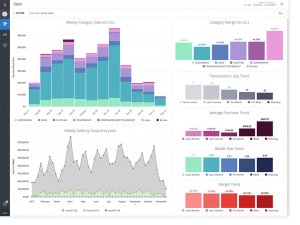
Stay on top of your pro shop with in-depth reports
4. How many staff members should be working?
Figuring out your staffing needs should not come down to trial and error. If you get it wrong, you’ll either be overstaffed and spending too much money, or understaffed and providing a bad customer experience. If you’ve been operating your golf course for a few years, you’ll probably have a good idea already of how many hands you’ll need on deck, but all of this is based on hunches and not on powerful data. There will still be errors in staffing numbers, which can hurt your bottom line.
With a good golf management software suite, you’ll be able to use past sales, staffing, and occupancy numbers to predict how many employees you’ll need at your operation each day. Don’t get caught throwing money away or compromising your customer experience, make informed choices.
5. Which staff members are doing the best?
Knowing which staff members are your best performers and which ones need a little more help is crucial to improving the sales in your pro shop. With BI software, you’ll be able to comb through sales numbers per employee to figure out who’s selling what. You can then meet with those employees to find out what they’re doing to push those products, and then train the lower performers to do the same thing.
You’ll be able to figure out what gets your customer base to buy different products, and then target them with those tactics. A more in-depth guide to making sales will also help when you hire new or seasonal workers, as you’ll be able to train them with specific strategies, instead of hoping that they figure out how to make sales on their own.
6. How is my operation performing compared to last year?
Golf course analytics tools give you the ability to look at a variety of key metrics year-over-year so you can benchmark against past performance. Tools like occupancy pace comparison, round pace comparison, or subscription dashboards clearly bench mark performance against last year and help with evaluation and decision making.
7. Which customers should I reward?
When you have a leaderboard that tells you your top ten customers in terms of spend or rounds booked, you get a very clear picture of who your absolute most loyal customers are. This a major opportunity to give out some big customer loyalty rewards. Tiering your customer loyalty strategy is perfect for rewarding your best customers, while encouraging competition amongst your customer base.
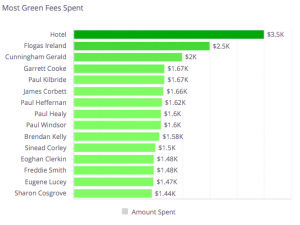
8. Which customers are causing revenue losses?
Unfortunately, not every customer or member is perfect. Some choose to cancel their rounds last minute, others simply don’t show up. These customers ultimately cost your business and need to be warned that their behaviour won’t be tolerated. No show and cancellation leaders can help you identify the leading culprits, so you can apply the fees or charges necessary to deter this kind of bad behaviour.
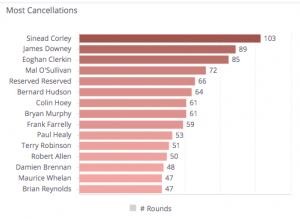
What kind of reports will your Business Intelligence software give you?
Your Business Intelligence tools should create reports that are ready to be viewed alongside the rest of your software. You’ll be able to quickly access graphic reports without leaving your tee sheet, so you can keep a finger on the pulse of your golf course at any time of the day. Here’s some examples of reports that you should have access to:
1. Daily rounds played by hour
This graph gives you a quick look at which tee times are the most popular. This information can be useful for every part of your operation including marketing, staffing, and pricing.
2. Reservations per days in advance
Reservations per day in advance is a powerful metric that gives you insight into customer behaviour. You should also be able to drill down into this data by player types, so you’ll know what kind of people are making reservations at different times. With this information, you can get much better timing for your promotions.
For example, if you know that public players typically make reservations 3 days before a tee time, you can create a discount for an available day and then promote it to public players through your social media 3 days in advance.
Ideally, you want players to book further in advance to aid planning for busy days and provide a better picture of how much revenue to expect. If you want to reduce last minute bookings at your golf course, this report is key for identifying the culprits and incentivizing early bookings with discounts or price hikes.
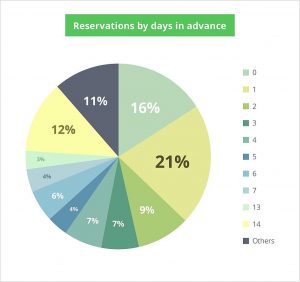
3. Performance heat map
This heat map is a way to get a top-level view of when your season peaks. You’ll get a visualization of your busiest and least busy days on a monthly calendar. With this data, you’ll be able to predict trends and prepare your pricing model.
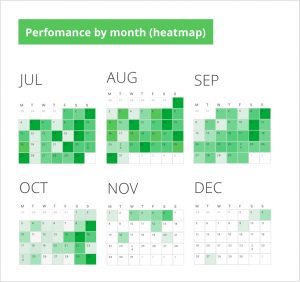
4. Debtors Dashboard
It’s not uncommon for golf courses to have members with outstanding balances, however tracking debt levels is difficult without tools that aggregate data. Understanding how much is owed by who in a clear dashboard can help with collections efforts and inform you whether there are any concerning trends.

5. Failed Payments Dashboard
When a customer misses a payment its critically important to the let them as soon as possible, to ensure that the issue is resolved and the cash is collected. Failed payments dashboards can help you quickly identify problem account and uncover any trends relating to payment failures.

6. Channel Booking Drill Down
Knowing where you bookings are coming from can help you identify gaps in your marketing strategy and give insights about customer behaviour. Booking channel drill reports display exactly what channels your booking are coming from, whether they are coming from online, barter websites, mobile apps, or phone calls.
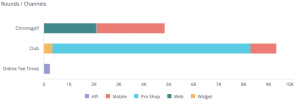
Where will all of this data come from?
The best part about a complete golf management software is that your BI tool will pull data that is collected from the rest of the system and aggregate it in a useful way. Your reports will be generated from the following parts of your integrated golf management suite:
- Customer Relationship Management
A CRM is a database of detailed customer information. What it does is collect data on golfers (like their name, email address, player type, & more) and record all of the interactions they have with your business. This information is a critical piece to the BI puzzle as it will allow you to dive deeper into data and understand how your different types of golfers behave.
- Tee Sheet
Your tee sheet is the main component of your management suite and provides loads of data on tee time occupancy. Selling tee times makes up a huge chunk of your business so viewing this information in a meaningful manner can really help you track what happens at your golf course over time.
- Point-of-sale
Your POS system processes and records all sales made. A detailed record of every transaction will be sent to your BI software, so you’ll know who was involved in the sale and what the customer bought. If you’re going to optimize your pro shop, you’ll need to back up any decision you make with actual sales data.
Are BI tools really worth the investment?
The short answer is yes. The longer answer involves taking a look at return on investment (ROI). ROI is a great measure for deciding where to spend your money because it gives you an idea if you’re actually going to add to your bottom line. According to Nucleus Research, Business Intelligence at this level delivers an average ROI of 389%, or $3.89 made for every $1.00 spent.
You have to make sure that the BI system you use integrates with your entire golf management system, this is key. Any lacklustre software won’t be worth the investment as the data you’ll generate will be incomplete and may result in incorrect conclusions.
The question of whether you can afford BI tools is quickly changing to whether you can afford not to have them. As more and more golf courses adopt new technology to lead their operations, those who cling to old systems will be left in the dust. If you’re notable to build your golf course business model based on analysis and predictability, you won’t be able to compete with your neighbouring golf courses.
Making use of data is so important in the modern business landscape. Competition is stiffer than ever, so remaining profitable often depends on how agile you can be to ever-changing demands. Golf managers have so much on their plate between managing day-to-day operations, and planning big picture growth. So, fuelling your decisions with the right information is key to success.

News you care about. Tips you can use.
Everything your business needs to grow, delivered straight to your inbox.



